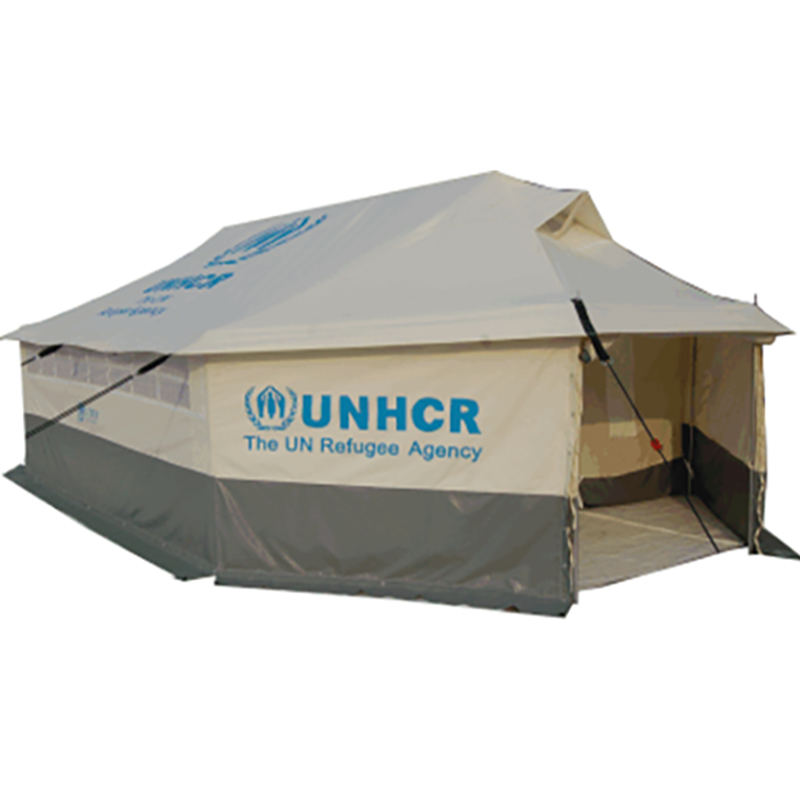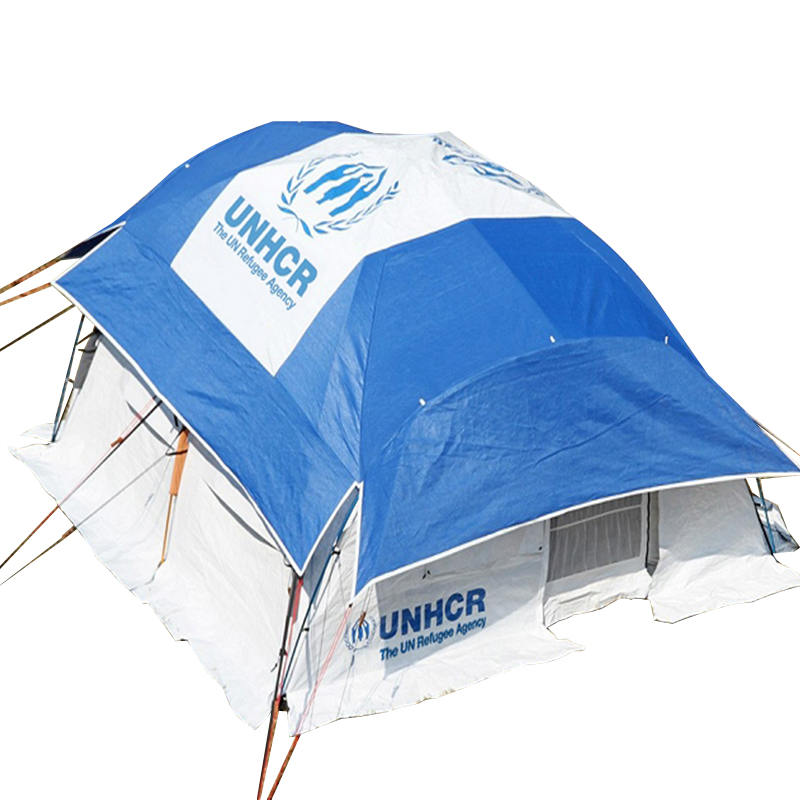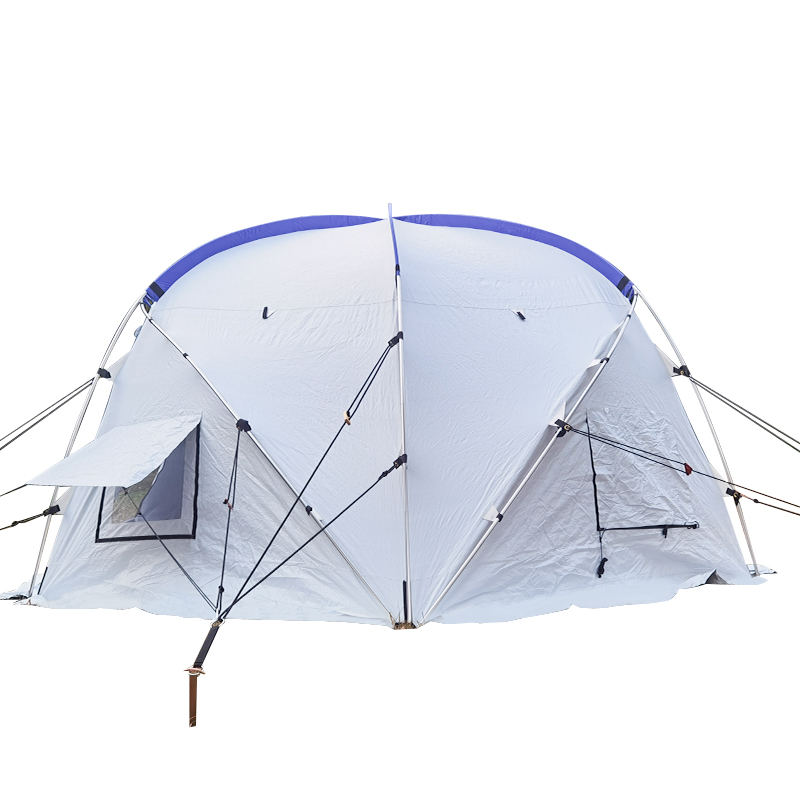Our story is about how to uphold the spirit of humanitarianism in the face of disaster, how to find solutions amidst challenges, and how to sow hope in despair.
Web Menu
Product Search
Exit Menu
Outdoor Storage Tents: How to Withstand 70mph Strong Winds? Are Frame and Fabric the Key?
Posted by Admin | 31 Oct
Content
- 1 What Wind Resistance Standards Correspond to 70mph Strong Winds, and What Performance Thresholds Must Tents Meet?
- 2 Are Frame and Fabric the Core of Wind Resistance? What Performance Indicators Should Be Focused On?
- 3 Beyond Frame and Fabric, What Structural Designs Help Enhance Wind Resistance?
- 4 What Additional Measures Are Needed for Special Scenarios to Ensure Wind Resistance?
- 5 What Common Misconceptions Should Be Avoided When Selecting Wind-Resistant Storage Tents?
In outdoor scenarios such as camping, field operations, and emergency supplies storage, outdoor storage tents need to cope with harsh weather conditions, especially strong winds. 70mph winds (equivalent to a 12-level strong wind) can easily cause tent collapse or damage, resulting in property loss. How can outdoor storage tents effectively resist such strong winds? Is choosing the right frame and fabric really the core of wind resistance? This article will conduct an in-depth analysis around these key issues.
What Wind Resistance Standards Correspond to 70mph Strong Winds, and What Performance Thresholds Must Tents Meet?
First, it is necessary to clarify the nature of 70mph strong winds and the corresponding performance requirements for tents. 70mph is approximately 112.65 km/h, which belongs to the range of 12-level strong winds in the Beaufort wind scale—at this wind speed, trees can be uprooted, and ordinary lightweight tents will be easily blown away. For outdoor storage tents to withstand such winds, they must meet strict performance thresholds.
From the structural perspective, the tent must have sufficient overall stability, and the maximum deformation under 70mph wind load should not exceed 15% of the tent height, and there should be no structural damage such as frame bending or fabric tearing. From the material perspective, the frame's bending strength must be able to withstand instantaneous wind pressure of at least 0.3 kPa (equivalent to the wind pressure of 12-level strong winds), and the fabric's tearing strength should not be less than 30 N in both warp and weft directions. In addition, the connection parts between the frame and fabric, as well as between the tent and the ground, must resist shear forces of more than 500 N to avoid disconnection under strong winds .
Are Frame and Fabric the Core of Wind Resistance? What Performance Indicators Should Be Focused On?
Frame and fabric are indeed the "double pillars" of outdoor storage tents' wind resistance, and their performance directly determines whether the tent can withstand 70mph strong winds.
For the frame, material and structural design are the two most critical indicators. In terms of material, low-cost glass fiber rods are far from meeting the requirements—they are prone to breaking under strong wind pressure. High-strength aluminum alloys are the basic choice, among which 7-series aviation aluminum (such as 7075 aluminum alloy) has excellent tensile and bending strength, and can maintain stability even under instantaneous wind impact . The diameter of the frame is also crucial: for medium-sized storage tents (about 5㎡), the main pole diameter should not be less than 8.5mm, and for large tents (more than 10㎡), it should be increased to 12mm or more. For example, a medium-sized storage tent equipped with 8.5mm 7-series aluminum alloy poles can withstand 8-level winds (about 45mph), and thicker poles of the same material can cope with higher wind speeds . In addition, the frame's connection structure should adopt reinforced designs—using integrated injection-molded joints instead of simple plug-in connections can increase the structural stability by 40%.
For the fabric, density, coating, and weaving process are key factors. The fabric density should be at least 210D, and high-density materials such as 420D Oxford cloth or 15D high-density nylon are more preferred—their tight weave structure can reduce wind penetration and improve wind resistance . The coating also plays an important role: PU coating can enhance the fabric's tensile strength, while silicone coating can reduce wind resistance by optimizing the surface smoothness. A storage tent using 15D nylon fabric with single silicon coating has a wind resistance 25% higher than ordinary uncoated fabric . In addition, the fabric's tear resistance must be guaranteed—adopting a grid weaving process or adding Dyneema fiber reinforcement at key positions (such as the connection between the tent top and poles) can prevent the tear from expanding after the fabric is scratched .
Beyond Frame and Fabric, What Structural Designs Help Enhance Wind Resistance?
While frame and fabric are the foundation, scientific structural design can further "amplify" the tent's wind resistance, enabling it to withstand 70mph strong winds through "force dispersion" and "aerodynamic optimization".
The aerodynamic shape design is the first line of defense against strong winds. Circular or dome-shaped tents are far more wind-resistant than rectangular or channel-shaped ones—their curved surfaces can guide the wind to flow around, reducing wind pressure on the tent surface by 30% compared to flat surfaces . Some inflatable storage tents adopt a diamond-like molecular structure, which can disperse wind force to multiple directions, allowing them to withstand 70km/h (about 43mph) winds, and similar structural designs can be upgraded to cope with 70mph winds . In addition, reducing the tent's height can lower the windward area—for storage tents that do not require high internal space, a height of less than 1.8m is more wind-resistant than a height of 2.5m.
The ground fixing system is also indispensable for wind resistance. Even the best frame and fabric will be useless if the tent is not firmly fixed to the ground. The fixing system should include three parts: ground nails, wind ropes, and weight-bearing base. The ground nails should use 7-series aluminum alloy triangular nails with a length of at least 25cm, and the number should not be less than 12 for a 5㎡ tent—driving them into the ground at a 45° angle can maximize the gripping force . The wind ropes should be made of high-strength polyester fiber with a breaking strength of more than 1000 N, and each wind rope should be tensioned to form a 30° angle with the ground, which can effectively disperse the wind force acting on the tent top to the ground . For areas where ground nails are difficult to fix (such as rocky ground), adding a weight-bearing base (each weighing at least 20kg) at the four corners of the tent can provide additional stability.
The internal reinforcement structure cannot be ignored either. Adding diagonal support poles inside the tent can form a triangular stable structure, which significantly improves the tent's resistance to lateral wind pressure. Some high-wind-resistance storage tents use Dyneema fiber to reinforce the pole crossing points, which can prevent the fabric from tearing at the stress concentration points and further enhance the overall stability .
What Additional Measures Are Needed for Special Scenarios to Ensure Wind Resistance?
In different outdoor environments, additional targeted measures are required to ensure that the storage tent can withstand 70mph strong winds.
In open areas without natural shelters (such as deserts or grasslands), the tent is fully exposed to strong winds, so it is necessary to increase the density of the fixing system. On the basis of the original ground nails and wind ropes, an additional "windbreak wall" can be set up 1-2 meters away from the windward side of the tent—using sandbags or wooden boards to build a low wall 50cm high can reduce the wind speed acting on the tent by 20-30% . For inflatable storage tents, ensuring that the internal pressure is maintained at 0.2-0.3 MPa is crucial—too low pressure will reduce the structural rigidity, while too high pressure may cause the air column to burst under wind impact .
In complex terrain such as mountain slopes or rocky areas, the tent should be placed in the leeward direction of natural obstacles (such as boulders or hillsides) to use the terrain to block the wind. When fixing the ground nails, if the ground is too hard, pre-drilling holes with a drill bit (diameter slightly smaller than the ground nail) can help the ground nails penetrate deeper. For tents placed on slopes, the downhill side should be equipped with additional weight-bearing bases to prevent the tent from sliding down due to wind force .
In cold and snowy areas, the tent must also consider the combined impact of wind and snow. The fabric should choose waterproof and anti-freezing materials (such as TPU composite fabric) to avoid water seepage and freezing, which may increase the tent's weight and reduce wind resistance. After snowfall, the snow on the tent top should be cleaned in time—each square meter of snow can increase the load by 5-10kg, which may cause the frame to bend when combined with strong winds .
What Common Misconceptions Should Be Avoided When Selecting Wind-Resistant Storage Tents?
Many people have misunderstandings when selecting wind-resistant storage tents, which may lead to insufficient wind resistance.
One common misconception is blindly pursuing lightweight while ignoring strength. Some users choose ultra-light tents with thin frames (less than 6mm in diameter) and lightweight fabrics (less than 100D) for portability, but such tents are almost impossible to withstand 70mph strong winds. For example, some ultra-light tents equipped with 7.5mm scandium alloy poles can only be used in mild weather, and their thin poles are prone to bending in strong winds . The correct approach is to prioritize wind resistance performance for storage tents, and then consider lightweight.
Another misconception is only focusing on the main frame while neglecting accessories. Some users spend a lot of money on high-strength frames but use cheap plastic joints and thin wind ropes. In fact, these accessories are the "weak links" of the tent—plastic joints may break under wind torque, and thin wind ropes may snap. It is necessary to ensure that the joints are made of reinforced nylon or metal, and the wind ropes have a breaking strength of more than 800 N .
The third misconception is ignoring the importance of professional testing reports. Many manufacturers claim their tents can "withstand strong winds", but without specific test data (such as wind speed resistance, material strength, etc.), such claims are not credible. When purchasing, you should ask for third-party test reports, focusing on indicators such as the frame's bending strength under wind load, the fabric's tearing strength, and the fixing system's pull-out force—only products that meet the 70mph wind resistance standards in the reports are reliable .
Related Products
- Cell Phone:+86 15695147631
- Cell Phone:+86 18630605111
-
Email:
[email protected]
[email protected]
[email protected] - Add:No.9 Kangmin Road, Automobile industry Park, Yizheng City, Jiangsu Province, China
Copyright © Yangzhou Mailenda Outdoor Products Co., Ltd.
All Rights Reserved.
Custom Tent OEM/ODM Manufacturers

- Privacy Statement
- Terms & Conditions
- Sitemap


 English
English 中文简体
中文简体 Español
Español 日本語
日本語 русский
русский عربى
عربى






